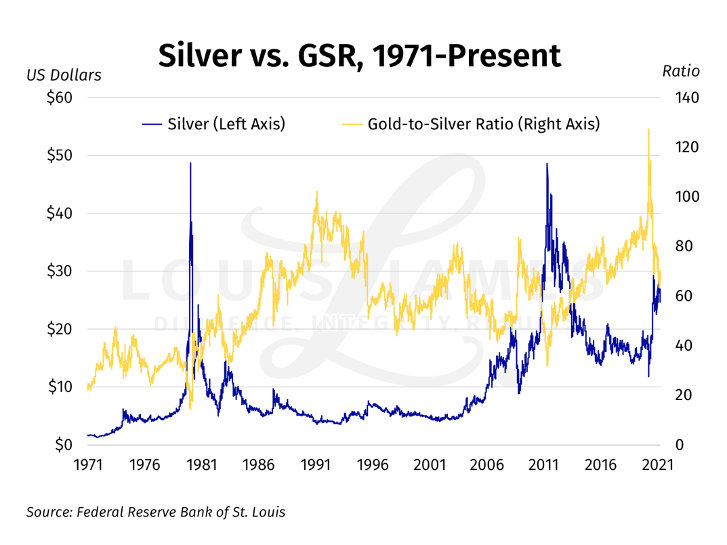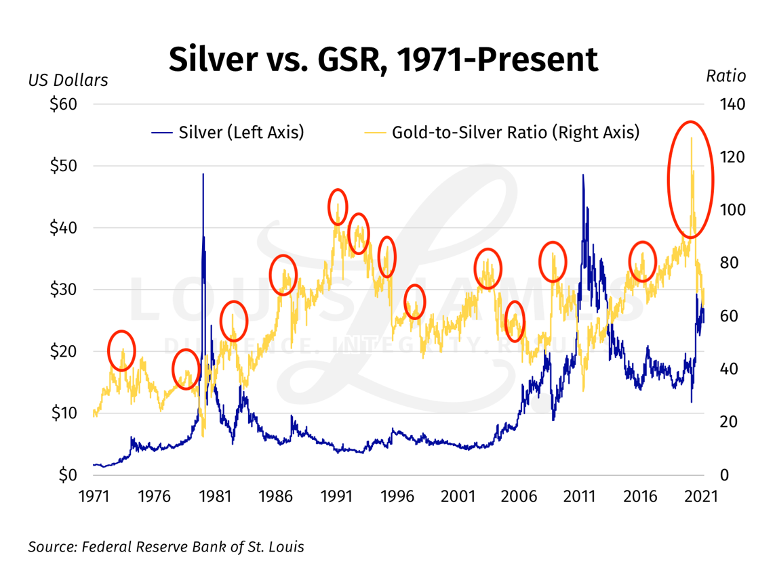For years, I’ve disagreed with my fellow silver bugs who pointed to historic highs in the gold-silver price ratio as evidence that silver prices had to go higher.
The gold-silver ratio can just as easily revert towards longer-term averages by gold prices falling as by silver prices rising.
I particularly disagree with the idea that the price ratio between the metals and the “natural” ratio of gold to silver in the Earth’s crust should be the same or similar. Prices are set by supply and demand—not just supply.
Silver has much greater industrial use than gold, so its demand is often different from gold. The effective end of silver use in film photography didn’t affect gold at the turn of the millennium. The galloping increase in demand for silver to make solar panels doesn’t affect gold now. Investment demand between the two is closely related, but industrial demand is not.
Back on the supply side, we have to remember that most of the silver mined is produced as a byproduct of large industrial metals mines—primarily copper, lead, and zinc. This makes new mine supply of silver supply less responsive to price than mine supply of gold is. And since silver gets consumed by industrial use—very little of which happens to gold—new mine supply is more important to silver than gold.
This being the case, it makes sense for silver prices to fall much more than gold prices during times of perceived economic prosperity and safety. So, of course this pushes the gold-silver ratio well above the ratio of the metals’ abundance in the Earth’s crust—and above long-term averages as well.
That’s why I’ve long said that the gold-silver ratio is interesting, but useless as a source of guidance.
Sure, when it gets extreme in either direction, it can be expected to revert—but that doesn’t mean silver prices have to rise.
All of the above remains true. My position hasn’t budged.
But…
While the gold-silver ratio itself may offer no useful guidance, changes in the ratio do indicate changes in the market for monetary metals, and just might offer some guidance on silver prices going forward.
To give credit where due, my rethinking along these lines was prompted by a talk given by Diora Esterlina of GoldandSilverAssets.com. She showed a simple chart of the silver vs. the gold-silver ratio, like this.

The generally inverse relationship this shows is no surprise. The big spikes in silver prices coinciding with sharp lows in the ratio makes perfect sense. What Diora pointed out, which I hadn’t really paid attention to before, is that the highs in the ratio do tend to lead silver rallies. I’ve circled the clear cases of this in this version of the chart.

Upon further reflection, this makes perfect sense as well. It’s well documented that gold always leads silver in a bull market, but then silver more than catches up. This means the gold-silver ratio must move higher before silver does—that’s just plain math.
I wish this gave us a tool for predicting when the gold-silver ratio will peak. Unfortunately, the fact that the gold-silver ratio is high—even notching record highs—does not prevent it from going even higher.
This does tell us that changes in the ratio of gold and silver prices do indeed offer guidance.
My mistake for missing this before.
I’m excited to find predictive value in changes to this much-cited ratio, but I have to rain a bit on my own parade now…
It would be a mistake to look at this chart and conclude that the reversal after the monster peak in the gold-silver ratio last year must mean that silver prices are going to soar much higher.
Don’t get me wrong; I do expect much higher silver prices ahead.
I think the odds favor silver reaching triple-digit prices.
But not because of the gold-silver ratio.
Note that the peaks in the ratio in the 1990s preceded small gains in silver prices. They still worked as leading indicators for silver rallies happening at all—but not for how high those rallies would take silver. In fact, the previous record high in the gold-silver ratio in the early 1990s preceded only a very modest increase in silver prices.
If we look at just the gold-silver ratio data, it could be that the recent rally in silver prices is all that the big reversal in the ratio last year was indicating.
If that’s so, why do I think silver might reach triple digits?
Well, as much as I welcome the silver short squeeze movement as a tailwind, that’s not it.
First and foremost, the monetary and industrial trends could scarcely be better for silver. This is why I call it the win-win metal for 2021.
Also, as mentioned above, in every gold and silver bull market since Richard Nixon took the US off the remnants of the gold standard in 1971, gold has risen first, and then silver has more than caught up. Silver has yet to “more than catch up.” When it does, that takes it to triple digits.
So yes, I’m a silver bull. And I will pay more attention to the gold-silver ratio now. But I’ll use it as a buy signal, not as a tool for predicting silver prices.
Caveat emptor,
![]()
P.S. To be kept abreast of more opportunities, dangers, and issues affecting investors, please sign up for our free, no-spam, weekly Speculator’s Digest.

